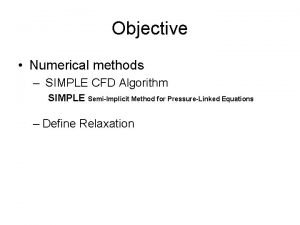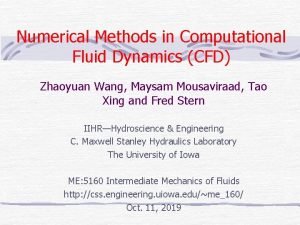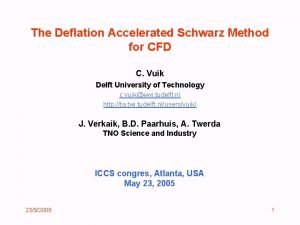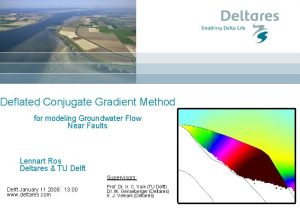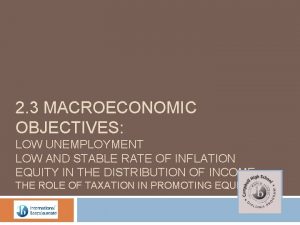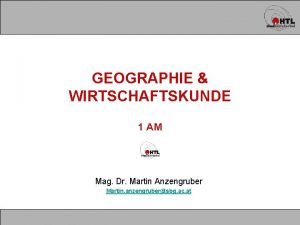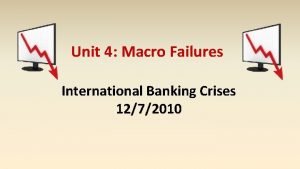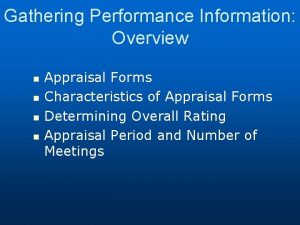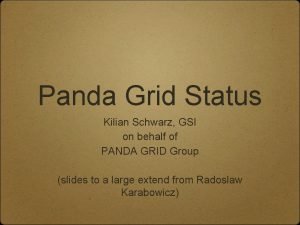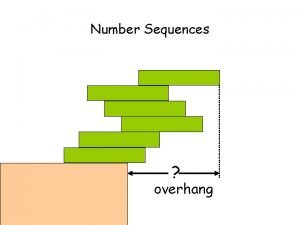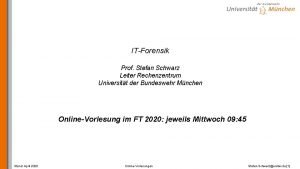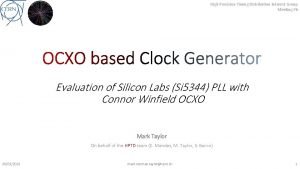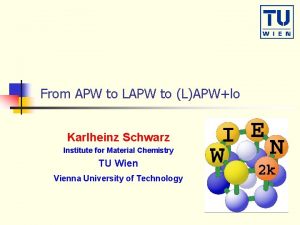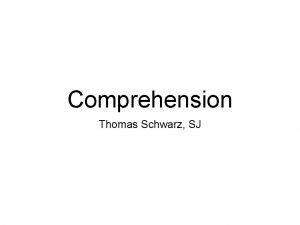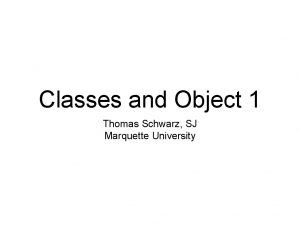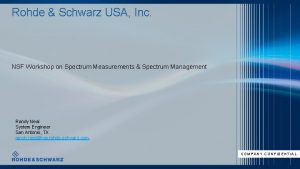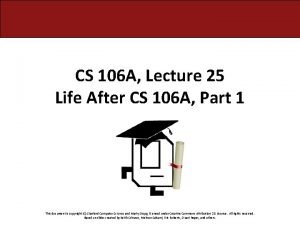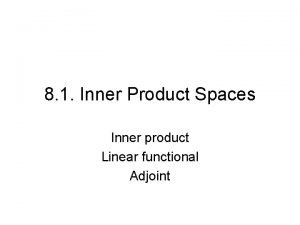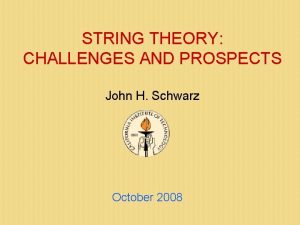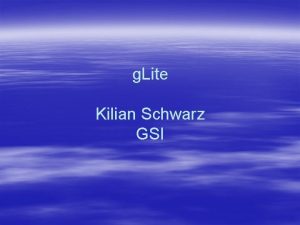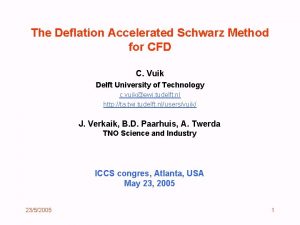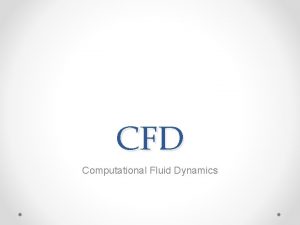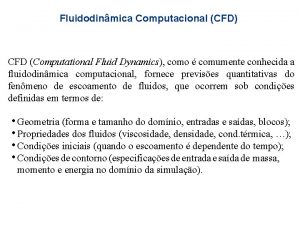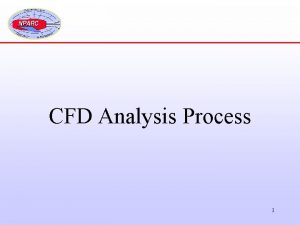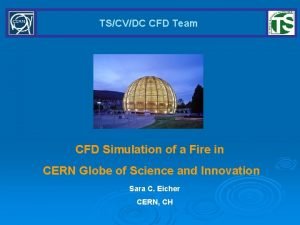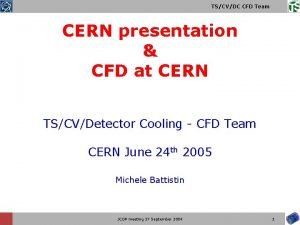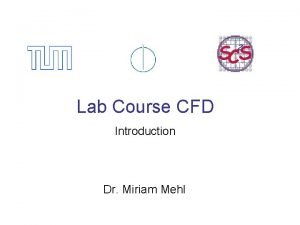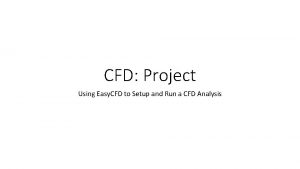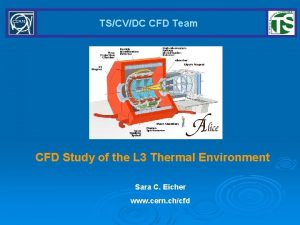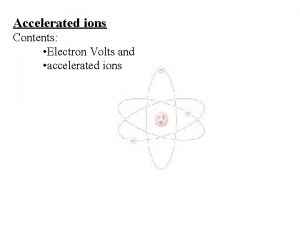The Deflation Accelerated Schwarz Method for CFD C

























- Slides: 25

The Deflation Accelerated Schwarz Method for CFD C. Vuik Delft University of Technology c. vuik@ewi. tudelft. nl http: //ta. twi. tudelft. nl/users/vuik/ J. Verkaik, B. D. Paarhuis, A. Twerda TNO Science and Industry ICCS congres, Atlanta, USA May 23, 2005 23/5/2005 1

Contents • • • Problem description Schwarz domain decomposition Deflation GCR Krylov subspace acceleration Numerical experiments Conclusions 23/5/2005 2

Problem description GTM-X: • • • CFD package TNO Science and Industry, The Netherlands simulation of glass melting furnaces incompressible Navier-Stokes equations, energy equation sophisticated physical models related to glass melting 23/5/2005 3

Problem description Incompressible Navier-Stokes equations: Discretisation: Finite Volume Method on “colocated” grid 23/5/2005 4

Problem description SIMPLE method: pressurecorrection system ( ) 23/5/2005 5

Schwarz domain decomposition Minimal overlap: Additive Schwarz: 23/5/2005 6

Schwarz domain decomposition GTM-X: • inaccurate solution to subdomain problems: 1 iteration SIP, SPTDMA or CG method • complex geometries • parallel computing • local grid refinement at subdomain level • solving different equations for different subdomains 23/5/2005 7

Deflation: basic idea Problem: convergence Schwarz method deteriorates for increasing number of subdomains Solution: “remove” smallest eigenvalues that slow down the Schwarz method 23/5/2005 8

Deflation: deflation vectors + 23/5/2005 9

Deflation: Neumann problem Property deflation method: systems with have to be solved by a direct method Problem: pressure-correction matrix is singular: has eigenvector for eigenvalue 0 singular Solution: adjust non-singular 23/5/2005 10

GCR Krylov acceleration Objective: efficient solution to Additive Schwarz: Property: slow convergence Krylov acceleration GCR Krylov method: • for general matrices (also singular) • approximates in Krylov space such that • is minimal • Gram-Schmidt orthonormalisation for search directions • optimisation of work and memory usage of Gram-Schmidt: restarting and truncating 23/5/2005 11

Numerical experiments 23/5/2005 12

Numerical experiments Buoyancy-driven cavity flow 23/5/2005 13

Numerical experiments Buoyancy-driven cavity flow: inner iterations 23/5/2005 14

Numerical experiments Buoyancy-driven cavity flow: outer iterations without deflation 23/5/2005 15

Numerical experiments Buoyancy-driven cavity flow: outer iterations with deflation 23/5/2005 16

Numerical experiments Buoyancy-driven cavity flow: outer iterations varying inner iterations 23/5/2005 17

Numerical experiments Glass tank model 23/5/2005 18

Numerical experiments Glass tank model: inner iterations 23/5/2005 19

Numerical experiments Glass tank model: outer iterations without deflation 23/5/2005 20

Numerical experiments Glass tank model: outer iterations with deflation 23/5/2005 21

Numerical experiments Glass tank model: outer iterations varying inner iterations 23/5/2005 22

Numerical experiments Heat conductivity flow h=30 Wm-2 K-1 T=303 K K = 1. 0 Wm-1 K-1 K = 100 Wm-1 K-1 Q=0 Wm-2 K = 0. 01 Wm-1 K-1 T=1773 K 23/5/2005 23

Numerical experiments Heat conductivity flow: inner iterations 23/5/2005 24

Conclusions • using linear deflation vectors seems most efficient • a large jump in the initial residual norm can be observed • higher convergence rates are obtained and wall-clock time can be gained • implementation in existing software packages can be done with relatively low effort • deflation can be applied to a wide range of problems 23/5/2005 25
 Cfd simple
Cfd simple What is cfl number in cfd
What is cfl number in cfd Hotelling deflation
Hotelling deflation Deflation
Deflation Deflation
Deflation Deflation
Deflation Deflation definition geographie
Deflation definition geographie 1272010
1272010 Cpi during the great depression
Cpi during the great depression Verbal descriptors in grading system
Verbal descriptors in grading system Who should provide performance information
Who should provide performance information Rohde & schwarz nrp z81
Rohde & schwarz nrp z81 Kilian schwarz
Kilian schwarz Cauchy schwarz inequality formula
Cauchy schwarz inequality formula Satz von schwarz thermodynamik
Satz von schwarz thermodynamik Rechenzentrum unibw
Rechenzentrum unibw Rohde & schwarz fswp8
Rohde & schwarz fswp8 Karlheinz schwarz
Karlheinz schwarz Farbpsychologie violett
Farbpsychologie violett Sjcontents
Sjcontents Thomas schwarz marquette university
Thomas schwarz marquette university Rohde & schwarz usa, inc.
Rohde & schwarz usa, inc. Cs
Cs Blak
Blak String schwarz
String schwarz Kilian schwarz
Kilian schwarz
